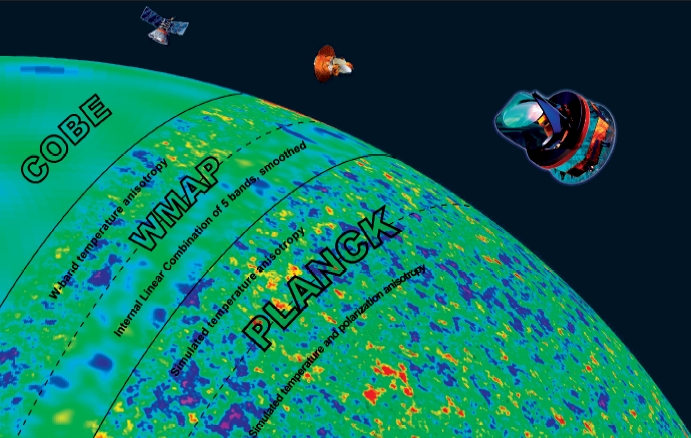Science Seen Physicist and Time One author Colin Gillespie helps you understand your world.
Making Sense of Space
Making Sense of Space
Last week we looked closer at the crisis in cosmology. Physicists are inventing increasingly implausible models to describe what they observe. Clinging to descriptions, they abandon understanding. Indeed some heavy-hitter physicists propose to abandon physics. For example, American Nobel-Prize-winning physicist Steven Weinberg says:
Now we may be at a new turning point, a radical change in what we accept as a legitimate foundation for a physical theory.
He means it is or should now be legitimate to publish solemn papers on the fancy math of fanciful ideas about space and cosmology―like multiverses―as if this is physics rather than math fiction. His proposal is a counsel of despair. He sees physics as painted into a corner that requires us to relinquish its relation to reality.
Fact is, it is in a corner thanks to past mistakes stacked on even older mistakes. Paraphrasing Spanish philosopher George Santayana, British Prime Minister Winston Churchill has, as usual, a pithy phrase:
Those that fail to learn from history are doomed to repeat it.
Of the former, American novelist Kurt Vonnegut has his character Mrs. Berman say:
“Is that a fact?” she said. “Well―I’ve got news for Mr. Santayana: we’re doomed to repeat the past no matter what.”
Though Churchill thinks that we can learn, he is not thinking of cosmology. Yet what he says applies to cosmology and to its history. When, in the early 1900s, cosmology emerges from astronomy and general relativity, it is mostly speculative metaphysics. Fifty years later it is experimental science. And in forty more years it’s the cutting edge of physics. Or it should be, but in truth it is a comedy of errors. This problem is expected. In 1916 Einstein says:
Concepts that have proven useful in ordering things, easily attain an authority over us such that we forget their Earthly origin and accept them as immutably given. … Such errors make the road of scientific progress often impassable for long times. Therefore it is not at all idle play when we are trained to analyze the entrenched concepts … and how they evolved from the experience at hand. This breaks their all too powerful authority.
Now, quoting this, Canadian cosmologist Daryl Janzen suggests it’s time to question the foundations of cosmology. He is in good company. American physicist Paul Steinhardt is a founder of a version of Cosmic Inflation, a nifty zap that he and others cooked up to fix Big Bang problems. CI is all fancy math pursuing the idea that the infant universe (just 10-36 second old) grew briefly (for about 10-33 second) faster than the speed of light from a tiny dot to millions of light years across before settling into the Big Bang. That’s a lot of new space in almost no time; yet it seems to fit some puzzling things about general relativity and the universe we see. But soon, as Steinhardt takes a closer look, he sees it doesn’t work. This doesn’t mean CI―no cottage industry―will die. Steinhardt says:
To this day the development and testing of the inflationary theory of the universe is one of the most active and successful areas of scientific investigation. 
To this day devotees are busy bending theory out of shape to make it fit. It still doesn’t work. The bending’s become so elaborate the whole point of the theory is lost. And―notwithstanding the chorus to the contrary―recent data (known as BICEP2) do not confirm it. Indeed, as Steinhardt and colleagues show, it is impossible to test.
As well as seeming to explain things that it doesn’t, CI math seems to fit data (from the Wilkinson Microwave Anisotropy Probe, the Atacama Cosmology Telescope and the Planck satellite). But again, a close look shows it doesn’t. Now Steinhardt says, let’s end the bending. In a paper with two colleagues he asks, ‘Is it time to seek an alternative cosmological paradigm?’
From their distinct perspectives, Janzen and Steinhardt say it is.
There’s no need for physics to forsake reality. With all due respect, Dr. Weinberg, you are wrong.
Sources:
George Santayana (1906), The Life of Reason: Or the Phases of Human Progress, London: Archibald Constable & Co. Ltd., vol. 1, p. 284; http://www.gutenberg.org/ebooks/15000
Kurt Vonnegut (1987), Bluebeard the Autobiography of Rabo Karabekian (1916–1988), New York: Delacorte Press, p. 91; http://www.nytimes.com/books/97/09/28/lifetimes/vonnegut-bluebird.html
Albert Einstein (1916), “Ernst Mach”, Physikalische Zeitschrift, vol. 17, p. 101; Alfred Engel (tr.) (1997), in Collected Papers of Albert Einstein, Princeton: Princeton University Press, vol. 6, p. 141; and see Daryl Janzen (2013), “A Critical Look at the Standard Cosmological Picture”, Ithaca: Cornell University Library, http://arxiv.org/pdf/1303.2549v3
Steven Weinberg (2007), “Living in the Multiverse”, in Universe or Multiverse, Bernard Carr (ed.), New York: Cambridge University Press, p.29; http://arxiv.org/abs/hep-th/0511037
Paul Steinhardt (2011), “The Inflation Debate”, Scientific American, May, p. 23; http://www.scientificamerican.com/article/the-inflation-summer/
Paul Steinhardt (2014), “Paul Steinhardt Disowns Inflation, the Theory He Helped Create: Is the Theory at the Heart of Modern Cosmology Deeply Flawed?”, Scientific American, August, vol. 23, issue 3s; http://www.scientificamerican.com/article/paul-steinhardt-disowns-inflation-the-theory-he-helped-create/
Anna Ijjes, Paul Steinhardt & Abraham Loeb (2014), “Inflationary schism after Planck2013”, Ithaca: Cornell University Library, http://arxiv.org/abs/1402.6980
Image credit: Julian Borrill, “Mapping the Universe to the Beginning of Time”, SciDAC Review, http://scidacreview.org/0704/html/cmb.html

“As well as seeming to explain things that it doesn’t”.
That’s it? This article seems to be completely devoid of any detail.